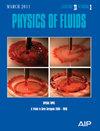水力发电系统中走廊形气垫式涌流室的水力和传热特性
IF 4.1
2区 工程技术
Q1 MECHANICS
引用次数: 0
摘要
水力发电系统中的走廊形气垫增压室具有较大的长宽比,因此具有不同于圆柱形的特殊水力和传热特性。对于节流孔处复杂的流入喷流和流出涡流现象,以及负荷变化时水气界面上的热能交换,人们的了解仍然有限。针对上述知识空白,我们采用计算流体动力学方法,利用流体体积模型精确模拟了负荷变化条件下的水力和热传递过程。分析了各种参数对压力和流动模式的影响(包括初始水深、孔径大小、涌流室长宽比和单位关闭时间)以及压缩和膨胀阶段空气的热力学响应。结果表明,孔径越小,弗劳德数越大,因此喷射高度越大,波浪波动越剧烈。增加初始水深或减小走廊形腔室的长宽比,可在负荷增加时降低孔口上方流体的角速度,从而减弱涡流强度。通过考虑水、腔壁和空气之间的热交换,开发了一种计算腔体内热传导率的方法。水-空气界面的强烈传热是由速度梯度引起的大波波动造成的。此外,孔径越大,流速和传热率越高,从而导致腔室的总传热系数增大。本文章由计算机程序翻译,如有差异,请以英文原文为准。
Hydraulic and heat transfer characteristics in corridor-shaped air-cushion surge chambers in hydropower systems
The large aspect ratio of a corridor-shaped air cushion surge chamber in hydropower systems results in special hydraulic and heat transfer characteristics that differ from those of cylindrical shapes. The complexities of inflow jet and outflow vortex phenomena at the throttle orifice, along with the thermal energy exchange across the water–air interface during load variations, continue to be areas of limited understanding. The hydraulic and heat transfer processes during the load variation conditions were simulated precisely using the volume of fluid model to address the above knowledge gap by adopting computational fluid dynamics. The effects of various parameters on pressure and flow patterns (including initial water depth, orifice size, aspect ratio of the surge chamber, and unit closure time) and the thermodynamic response of the air during the compression and expansion phases were analyzed. The results indicate that a smaller orifice size has larger Froude numbers, thus intensifying jet heights and exacerbating wave fluctuations. An increased initial water depth or a reduced aspect ratio of the corridor-shaped chamber decreases the angular velocity of the fluid above the orifice during load increase, thus attenuating the vortex intensity. A method for calculating the heat transfer rate in the chamber was developed by considering the heat exchanges between water, chamber wall, and air. The intense heat transfer at the water–air interface is caused by large wave fluctuations due to velocity gradients. In addition, larger orifice size increases the flow rate and heat transfer rate, leading to an increase in the total heat transfer coefficient of the chamber.
求助全文
通过发布文献求助,成功后即可免费获取论文全文。
去求助
来源期刊

Physics of Fluids
物理-力学
CiteScore
6.50
自引率
41.30%
发文量
2063
审稿时长
2.6 months
期刊介绍:
Physics of Fluids (PoF) is a preeminent journal devoted to publishing original theoretical, computational, and experimental contributions to the understanding of the dynamics of gases, liquids, and complex or multiphase fluids. Topics published in PoF are diverse and reflect the most important subjects in fluid dynamics, including, but not limited to:
-Acoustics
-Aerospace and aeronautical flow
-Astrophysical flow
-Biofluid mechanics
-Cavitation and cavitating flows
-Combustion flows
-Complex fluids
-Compressible flow
-Computational fluid dynamics
-Contact lines
-Continuum mechanics
-Convection
-Cryogenic flow
-Droplets
-Electrical and magnetic effects in fluid flow
-Foam, bubble, and film mechanics
-Flow control
-Flow instability and transition
-Flow orientation and anisotropy
-Flows with other transport phenomena
-Flows with complex boundary conditions
-Flow visualization
-Fluid mechanics
-Fluid physical properties
-Fluid–structure interactions
-Free surface flows
-Geophysical flow
-Interfacial flow
-Knudsen flow
-Laminar flow
-Liquid crystals
-Mathematics of fluids
-Micro- and nanofluid mechanics
-Mixing
-Molecular theory
-Nanofluidics
-Particulate, multiphase, and granular flow
-Processing flows
-Relativistic fluid mechanics
-Rotating flows
-Shock wave phenomena
-Soft matter
-Stratified flows
-Supercritical fluids
-Superfluidity
-Thermodynamics of flow systems
-Transonic flow
-Turbulent flow
-Viscous and non-Newtonian flow
-Viscoelasticity
-Vortex dynamics
-Waves
 求助内容:
求助内容: 应助结果提醒方式:
应助结果提醒方式:


